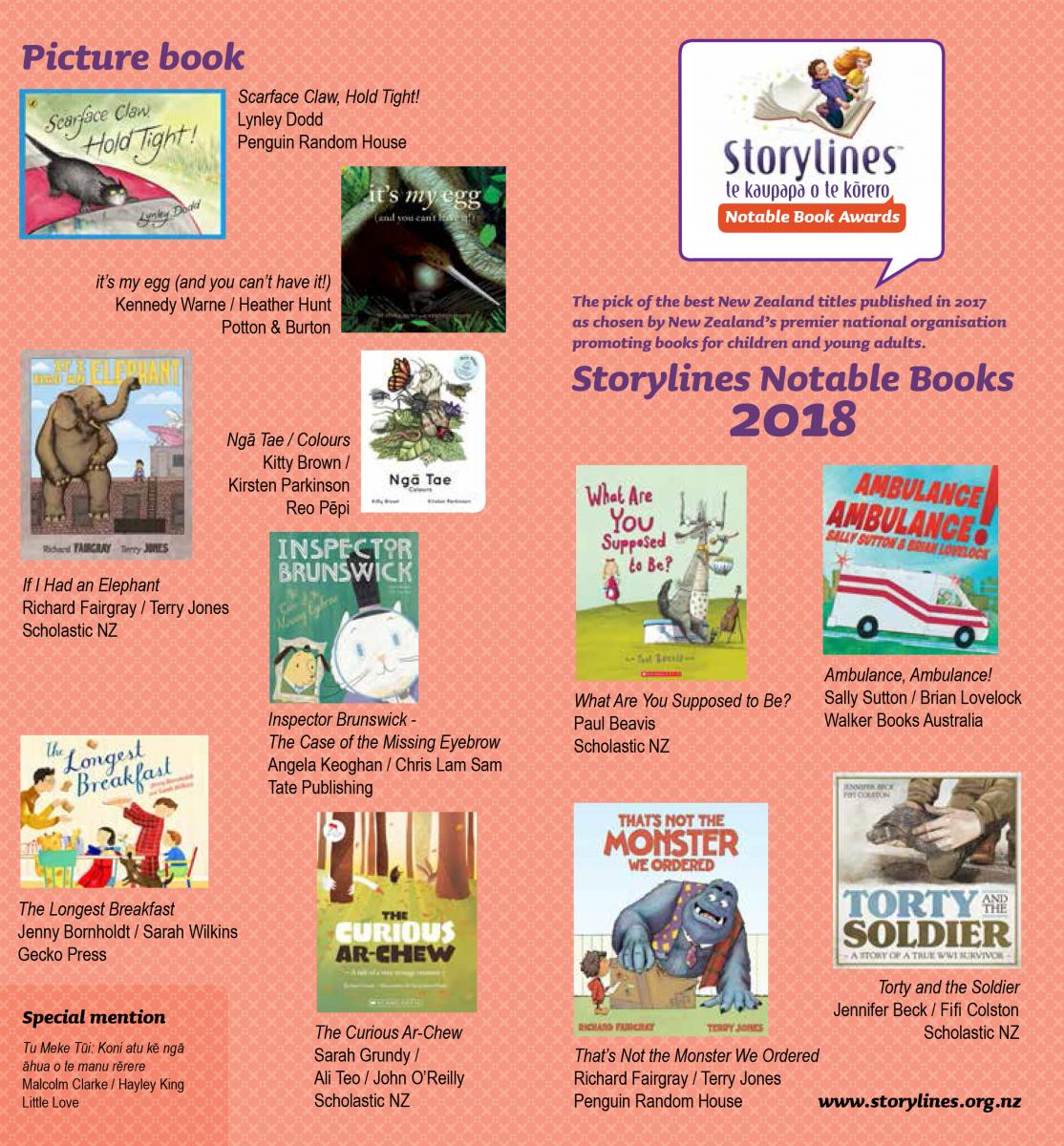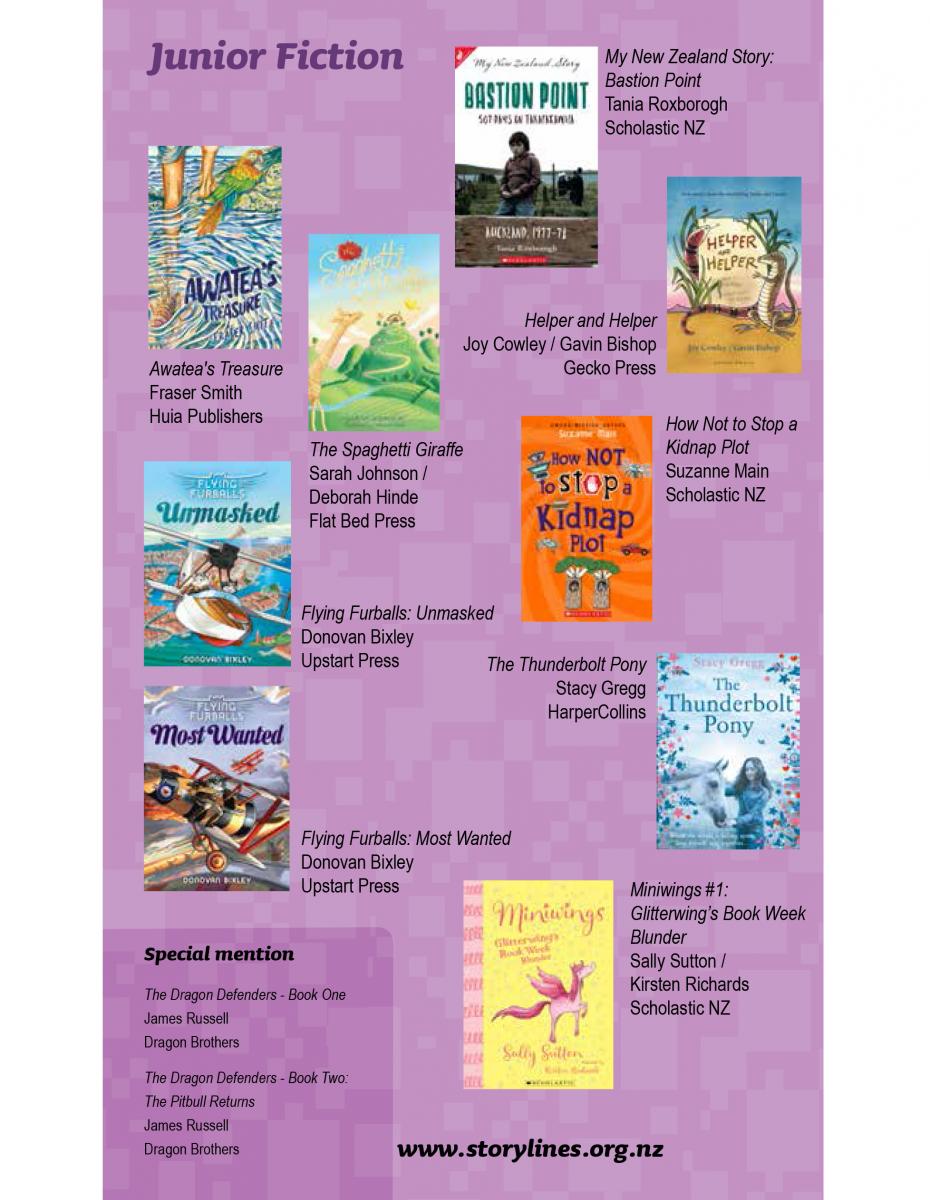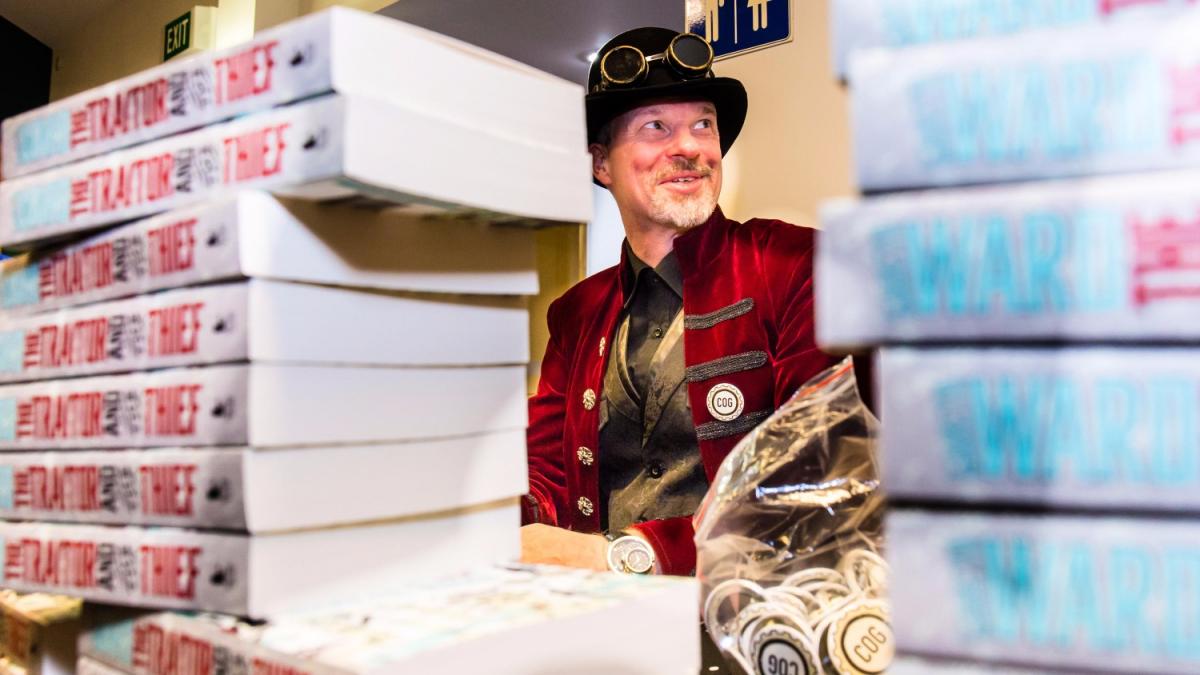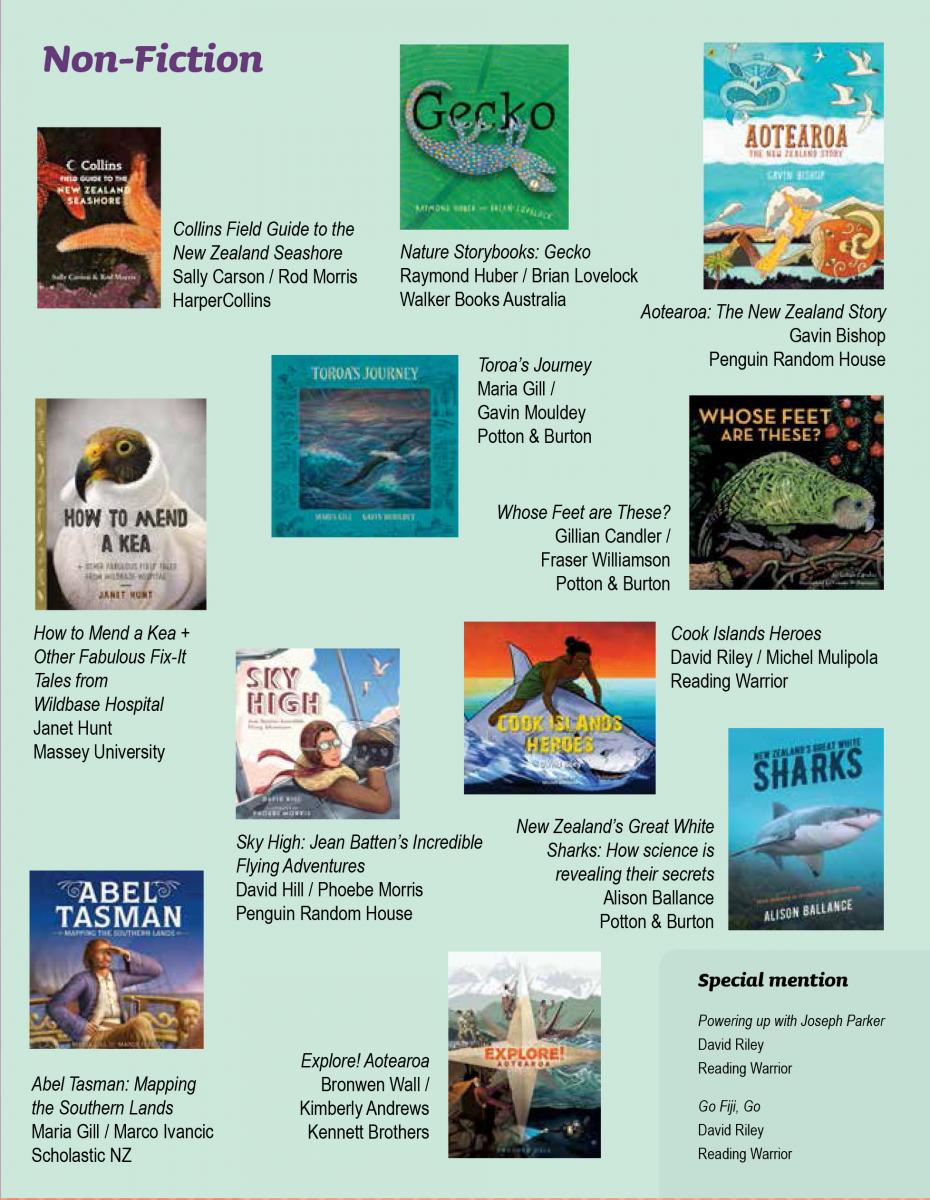2:16 PM, 5 April 2018
This year sees the 18th iteration of the Storylines Children’s Literature Trust Notable Books list. The list is released in March each year, and sees 40+ titles named as Notable Books, echoing similarly named lists in Australia (CBCA) and America (ALA). The growth of children’s books as a sales sector makes this list exceptionally important as a sales tool for bookshop staff – particularly those who are not around children’s books at home.
As I am not only the Communications Manager for Booksellers NZ, but also an Editor and regular reviewer of children’s books for mine and Jane Arthur’s website The Sapling, I am familiar with most of these titles, and this year I have broken down the category lists into audiences for your ease of use. I have also had a chat to Storylines Committee Member Tessa Duder about what she’d like to see booksellers do with the awards, and how they are judged. There are seven judges per category!
Storylines & their friends
Tessa Duder came to the Booksellers NZ conference last year, to talk a little about the various awards they offer, and to promote the Notable Books list. She has noted this year, ‘Storylines would like to see every bookseller in the country aware of the list published each March and using it on a regular basis to advise customers and keep themselves up-to-date on children’s publishing in New Zealand.’
These book lists are judged by panels of seven judges for each of the four genre (young adult, picture book, non-fiction and junior fiction). For the first time, in 2018 there was also a panel for books in te reo Māori. Tessa notes, ‘These judges are children’s book professionals: school and public children’s librarians, teachers, authors, illustrators, academics, booksellers. Each one is appointed for their knowledge of the particular genre.’
These judges meet several times throughout the second half of the year, discussing the books in terms of several criteria. Tessa says, ‘These include literary merit, pacing and tone, book design and editing, authenticity of plot, believable characterisation, quality of dialogue, settings and atmosphere, general appeal and appropriateness for the age of the young reader.’ A thorough process.
So how about the books? Which ones should we recommend as gifts for babies? As the perfect present for a 4-year-old? Or to sell to childcare centres, schools, disaffected teens? Let’s have a look.

Picture Books
While many people think of picture books as for little kids only, have you ever walked into a school library? You can guarantee they have hundreds of picture books. This hardy, often beautiful format stretches up until kids are much older, particularly when there are more complex concepts at play. They are used in schools for comprehension, and they draw kids in through the complexity of interplay between text and images.
So, here is what we have in this year’s list. There are two titles – one from the main list and one additional – that I’d suggest for baby presents. These are both te reo titles: Ngā Tae / Colours, by Kitty Brown & Kirsten Parkinson and Tu Meke Tui: Koni atu kē ngā āhua o te manu rērere, by Malcolm Clarke & Hayley King. Both of these are board books, and each has simple language and eye-catching illustrations.
There are several in this list that have strong rhyme schemes, which are equally great for reading to small babies: Ambulance, Ambulance! by Sally Sutton & Brian Lovelock – Sally Sutton can be relied upon for a fabulous rhyme with lots of onomatopoeia; The Curious Ar-Chew, a debut by Sarah Grundy, with illustrators Ali Teo & John O’Reilly – this won the 2016 Joy Cowley Award and is a fun romp into the forest; and Scarface Claw, Hold Tight!, by Lynley Dodd – another in the Hairy Maclary and Friends series of adventures, starring the mischievous Scarface Claw.
Two more that are for younger kids, driven by imagination, are The Longest Breakfast, by Jenny Bornholdt & Sarah Wilkins and If I had an Elephant, by Richard Fairgray & Terry Jones. The first is a fabulous take on a chaotic breakfast with a diverse cast of characters, the second is a whimsical dream of what you might get up to had you an Elephant on hand.
For the slightly older age range (4+), for children’s gifts and schools, the final five are for the interrogators, and those who are starting to think a bit more deeply. Two of these are non-fiction: It's My Egg and You Can’t Have It, by Kennedy Warne & Heather Hunt – about the natural predators of our kiwi and how to protect them, and Torty and the Soldier, by Jennifer Beck & Fifi Colston – a gentle introduction to animals at war.
The others are What are you Supposed to Be? By Paul Beavis – challenging the stereotype of what exactly a wolf/man/person ought to be interested in; That’s not the Monster We Ordered , by Richard Fairgray – a story about the perils of online shopping (for monsters); and Inspector Brunswick: The Case of the Missing Eyebrow, by Angela Keoghan & Chris Lam Sam – an internationally-published mystery in the museum drama.

Junior Fiction
While most bookshops have now divided their shelves into junior and middle fiction, due to the size of the publishing pool in New Zealand, these titles are still categorised as Junior Fiction for the sake of the Storylines Notable Books and NZ Book Awards for Children & Young Adults. The junior fiction range caters to the starter reader, who is just beginning to read alone. This often includes illustrations. The middle fiction is for those who are more established and who are starting to choose their own books, often by genre.
For those 6-7 year old kids who have just decided that they like reading to themselves, here are the selections from this list of nine: Miniwings #1: Glitterwing’s Book Week Blunder, by Sally Sutton & Kirsten Richards – this is a fabulous adventure featuring two sisters and some incredibly naughty toy horses that come alive; The Spaghetti Giraffe, by Sarah Johnson & Deborah Hinde – a kitchen adventure with animals made of food; plus two in the Flying Furballs series by Donovan Biley – Most Wanted, and Unmasked. I’ve likened this series to Biggles but with cats, and it is actually pitched just a little older than the others, for 8-9 year olds that are at the same stage of literacy.
A great read-aloud for parents and grandparents to discuss with younger school-age children is Helper & Helper, the third in the Snake and Lizard series by Joy Cowley and Gavin Bishop.
The next three are great for those who like reality-based fiction, age 8+. The Thunderbolt Pony, by Stacy Gregg, is set in the aftermath of the Kaikoura earthquake; My New Zealand Story: Bastion Point, by Tania Roxborogh is a retelling of the occupation of Bastion Point which won the Junior Fiction Award last year in the NZCYA; Awatea’s Treasure, by Fraser Smith is set in the late 1950’s, telling the adventure of a young boy sent to live with his grandparents while his dad is ill. And in the humour category, we have How Not to Stop a Kidnap Plot, a school-based story of mishaps, by Suzanne Main.
There are two special awards in middle fiction, and these go to the two Dragon Brothers books, the first to be published in NZ with AR functionality. These would be good for kids who like their books with bells and whistles (and refuse to put their phones down).

Young Adult fiction
Young Adult fiction is a traditionally strong publishing category in New Zealand, and it is good to see that OneTree House is carrying on this tradition with their list in 2018. Storylines has recognised five titles in this category.
First, we have two titles in the fantasy genre, namely the NZCYA award-winning Severed Land, by Maurice Gee, set in an allegorical world in which there is a mystical wall, and four ruling families battling in their self-made dystopia – if politics & despots with amazing world-building is your teens’ thing, what are you waiting for; and the 2016 Storylines Tessa Duder award-winning The Traitor and the Thief, by bookseller Gareth Ward, a steampunk fantasy adventure pitched at lovers of Phillip Reeve and his ilk.
For those teens that gravitate to ‘sick lit’ (John Green & his kin), we have Pieces of You, by Eileen Merriman – a story of love, depression and self-harm, with some great chapter titles; and Zeustian Logic, by Sabrina Malcolm – a father lost on Everest, a mother who can’t cope, and a boy who is doing his best to make sense of his changed world for the sake of his little brother. There is plenty in there to consider for the thoughtful teen.
Finally in YA, we have David Hill’s Flight Path, for those who want to know more about our history, in an engaging story by a master storyteller.

Non-fiction Category
For my money, 2017 was the best year for non-fiction for about a decade. It’s rare that so many stunning books are published at once, and across a broad audience within non-fiction. If you weren’t previously selling much home-grown non-fiction, hopefully Aotearoa by Gavin Bishop has changed this, and opened up this world of well-designed, informative publishing for your regular patrons. Of course Aotearoa is on this list, and pitched across all age ranges 5+ with its incredible illustrations & insightful history.
At the younger end of the scale – for children with readers aged 4+, we have Whose Feet are These?, by Gillian Candler & Fraser Williamson; Toroa's Journey, by Maria Gill & Gavin Mouldey; Abel Tasman: Mapping the Southern Lands, by Maria Gill & Marco Ivancic; Sky High: Jean Batten’s Incredible Flying Adventures, by David Hill and Nature Storybooks: Gecko, by Raymond Huber & Brian Lovelock. Each of these tackles either a natural phenomenon or a historical figure and makes them accessible for the very young. Toroa’s Journey is my particular recommendation in this batch, for the lush illustrations of albatrosses.
And for those older kids who are interested in our environment, Storylines recommends New Zealand’s Great White Sharks: How science is revealing their secrets, by Alison Ballance – I have a 6yo friend who was obsessed with this title for months; Collins Field Guide to the New Zealand Seashore, by Sally Carson & Rod Morris – super useful on those beach jaunts; and the spectacular How to Mend a Kea + Other Fabulous Fix-it Tales from Wild Base Hospital, by Janet Hunt, which has fabulous stories of healing from Wild Base Hospital. Check out Giselle’s review of it on The Sapling.
Finally, for kids that can’t get enough of Rebel Girls, we have two more books of heroes for them: Cook Islands Heroes, by David Riley & Michel Mulipola and Explore! Aotearoa, by Bronwen Wall & Kimberly Andrews. Each of these has a selection of inspirational heroes, and a good gender balance.
So download the flier, and order these books in – they are sure-fire successes in an ever-moving world of publishing.
Reviewed by Sarah Forster
The Storylines Notable Books will be awarded, alongside the Margaret Mahy Medal & Lecture and the winners of the Storylines Tessa Duder, Tom Fitzgibbon and Joy Cowley Award competitions, and the award of the Gaelyn Gordon Award for a Best-Loved Book, on Sunday 8 April 2018.